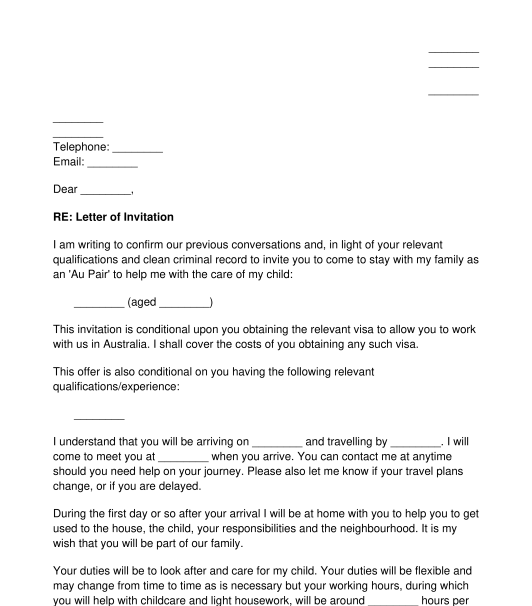 31/01/2025
31/01/2025

Answer a few questions and your document is created automatically.

Your document is ready! You will receive it in Word and PDF formats. You will be able to modify it.

 31/01/2025
31/01/2025
 Word and PDF
Word and PDF
 2 to 3 pages
2 to 3 pages
This is an invitation letter which can be sent to an au pair who is coming to live with a host family in Australia. It sets out the details of the relationship between the au pair and the family. It may also be used by the au pair when travelling, to provide evidence to immigration officials, airline staff, travel insurers or other relevant parties.
An au pair is a person who comes to live with a family (the host family) to help with things like housework and caring for children. Usually, an au pair is a young person from a country outside Australia, and they may use the experience as an opportunity to live in Australia and experience Australian culture. In some cases, au pairs speak a language other than English at home, so they may use the experience to improve their English, and they may even be able to teach the host family (and especially the children) some of their language.
This document can be amended to reflect the key aspects of the agreement including:
In all circumstances the au pair should consider whether they are required to pay their own insurance and income tax. They will also need to have the legal right to work in Australia (for example, they will need a work visa).
Host families using this document may need to consider the differences between a contractor and an employee. These differences are discussed in detail in our legal guide What's the Difference Between an Employee and an Independent Contractor?
In most cases in Australia, au pairs are considered employees, which means the host family needs to comply with all of the minimum employee entitlements such as payment of the minimum wage, superannuation, and leave.
The difference between an employee and a contractor is based on many factors, and no single factor is determinative. Simply calling the au pair a "contractor" is not enough to convert them from an employee into a contractor. Instead, Australian courts will look at the entire arrangement. In determining whether a worker is a contractor, some common considerations include:
It is against the law to incorrectly treat a worker as a contractor when they should be treated as an employee. In doing this, the employer will be neglecting their various obligations such as payment of superannuation and employee entitlements. There can be significant penalties associated with this.
Further information is available through the Australian Taxation Office, the Fair Work Ombudsman or business.gov.au. Please also see the "Applicable Law" section below, and consider getting legal advice if further information is required.
A host family can use this document to invite an au pair to come to Australia and work with them.
The document can be prepared by filling in all of the details of the arrangement between the au pair and the family. If the au pair is being hired as an employee, then the host family can also prepare a copy of our Employment Agreement. If the au pair is being hired as a contractor, then the host family can also prepare a copy of our Service Agreement. The relevant agreement can then be attached to the letter. The host family can sign the documents and send them to the au pair (sending copies of the signed documents by email is ok).
The au pair can sign the documents and send a copy back to the host family. They can also print a copy of the fully signed documents and bring them in their carry on luggage, so that they can be shown to immigration officials or airline staff as required.
If the au pair is being hired as an employee, then the host family is required to also provide the au pair with a copy of the Fair Work Information Statement which is published by the Fair Work Ombudsman.
General principles of contract law apply to the agreement between the au pair and the host family.
The Fair Work Act 2009 (Commonwealth) deals with employment in Australia, including the issue of whether a person is an employee or a contractor. An employment award such as the Miscellaneous Award may also apply to the au pair.
The Migration Act 1958 (Commonwealth) deals with migration and work visas in Australia.
The Income Tax Assessment Act 1936 and the Income Tax Assessment Act 1997 deal with the payment of income tax by workers in Australia.
You fill out a form. The document is created before your eyes as you respond to the questions.
At the end, you receive it in Word and PDF formats. You can modify it and reuse it.
A guide to help you: How to Send a Letter
Au Pair Invitation Letter - sample template
Country: Australia